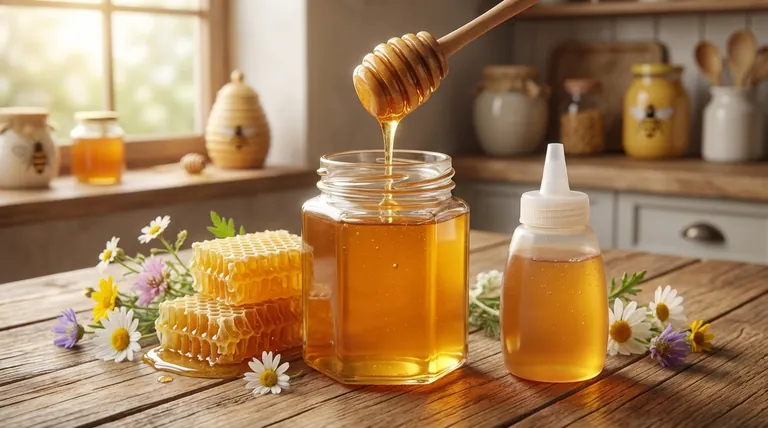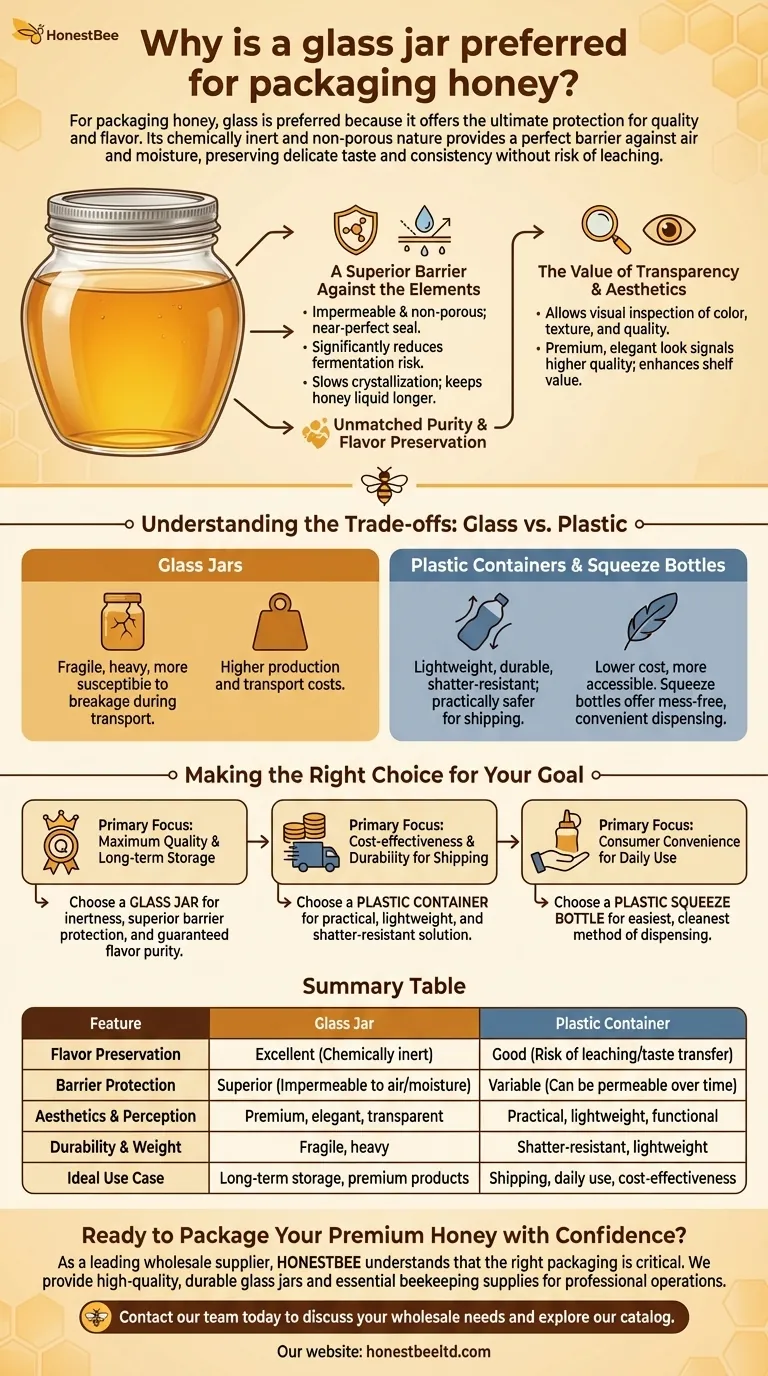For packaging honey, glass is preferred because it offers the ultimate protection for quality and flavor. As a chemically inert and non-porous material, glass provides a perfect barrier against air and moisture. This preserves the honey's delicate taste, aroma, and consistency over long periods without any risk of chemical leaching from the container itself.
The choice of packaging for honey is fundamentally a decision between prioritizing absolute purity and long-term preservation versus practicality and cost. Glass is chemically inert and impermeable, offering the best possible protection for honey's delicate composition, while alternatives like plastic serve needs for durability and convenience.

The Core Advantages of Glass Packaging
To understand why glass remains the gold standard for honey, especially for premium products, we need to look at its fundamental material properties.
Unmatched Purity and Flavor Preservation
Glass is chemically inert, meaning it does not react with the honey it holds. This is critical for maintaining the authentic, nuanced flavor profile of the honey.
Unlike some plastics, glass imparts no foreign tastes or odors. It also prevents any chemical leaching, ensuring the honey remains as pure as it was when harvested.
A Superior Barrier Against the Elements
Honey's primary enemies are moisture and air. Glass is impermeable and non-porous, creating a near-perfect seal against these external factors when lidded properly.
This superior barrier significantly reduces the risk of fermentation and slows the natural process of crystallization, keeping the honey in its ideal liquid state for longer.
The Value of Transparency and Aesthetics
The clarity of glass allows consumers to visually inspect the honey's color, texture, and quality before purchase. This transparency is a key indicator of purity.
Furthermore, a glass jar provides a premium, elegant look that often signals a higher-quality product, enhancing its value on the shelf.
Understanding the Trade-offs: Glass vs. Plastic
While glass is superior for preservation, it is not the only option. Plastic containers serve important roles, and the choice involves clear trade-offs.
Durability and Shipping Concerns
The most significant drawback of glass is its fragility. It is heavier and more susceptible to breakage during transport.
Plastic containers are lightweight, durable, and shatter-resistant, making them a more practical and often safer choice for shipping and handling.
Cost and Accessibility
Plastic packaging is typically less expensive to produce and transport than glass. This cost difference can be a major factor for large-scale producers.
User Convenience
For daily use, plastic often offers more convenience. Plastic squeeze bottles, for example, provide easy, mess-free dispensing that is not possible with a traditional glass jar.
Making the Right Choice for Your Goal
The best container depends entirely on your priority. By understanding the properties of each material, you can make an informed decision.
- If your primary focus is maximum quality and long-term storage: Choose a glass jar for its inertness and superior barrier protection, which guarantees flavor purity.
- If your primary focus is cost-effectiveness and durability for shipping: A plastic container offers a practical, lightweight, and shatter-resistant solution.
- If your primary focus is consumer convenience for daily use: A plastic squeeze bottle provides the easiest and cleanest method for dispensing honey.
Ultimately, understanding these material properties empowers you to select the packaging that best aligns with your goals for preserving and enjoying honey.
Summary Table:
| Feature | Glass Jar | Plastic Container |
|---|---|---|
| Flavor Preservation | Excellent (Chemically inert) | Good (Risk of leaching/taste transfer) |
| Barrier Protection | Superior (Impermeable to air/moisture) | Variable (Can be permeable over time) |
| Aesthetics & Perception | Premium, elegant, transparent | Practical, lightweight, functional |
| Durability & Weight | Fragile, heavy | Shatter-resistant, lightweight |
| Ideal Use Case | Long-term storage, premium products | Shipping, daily use, cost-effectiveness |
Ready to Package Your Premium Honey with Confidence?
As a leading wholesale supplier to commercial apiaries and beekeeping equipment distributors, HONESTBEE understands that the right packaging is critical to protecting your product's quality and your brand's reputation. We provide high-quality, durable glass jars and other essential beekeeping supplies designed for professional operations.
Let us help you source the perfect packaging solution to ensure your honey arrives with its flavor and purity perfectly preserved. Contact our team today to discuss your wholesale needs and explore our full catalog of reliable beekeeping equipment.
Visual Guide

Related Products
- Hexagonal Glass Honey Jars with Metal Lug Caps Elegant Versatile Packaging
- Classic Drum Shaped Glass Honey Jar with Airtight Lid
- Inverted Squeezable Honey Jar with No Drip Flip Top Cap for Easy Pouring
- Classic Honey Bear Jars with Flip Top Dispensing Cap for Liquid Sweeteners
- Pneumatic Double Nozzle Honey Filling Bottling Packaging Machine
People Also Ask
- What are the advantages of using glass jars for honey packaging? Preserve Purity & Elevate Your Brand
- What is the term for honey can absorb moisture from the air? Understanding Hygroscopy
- What are the common types of honey packaging? A Guide to Glass, Plastic, Pouches & Tins
- How many jars of honey do you get from a hive? Unlock Sustainable Harvesting Secrets
- What is the best way to jar honey? Preserve Quality with the Right Container



















